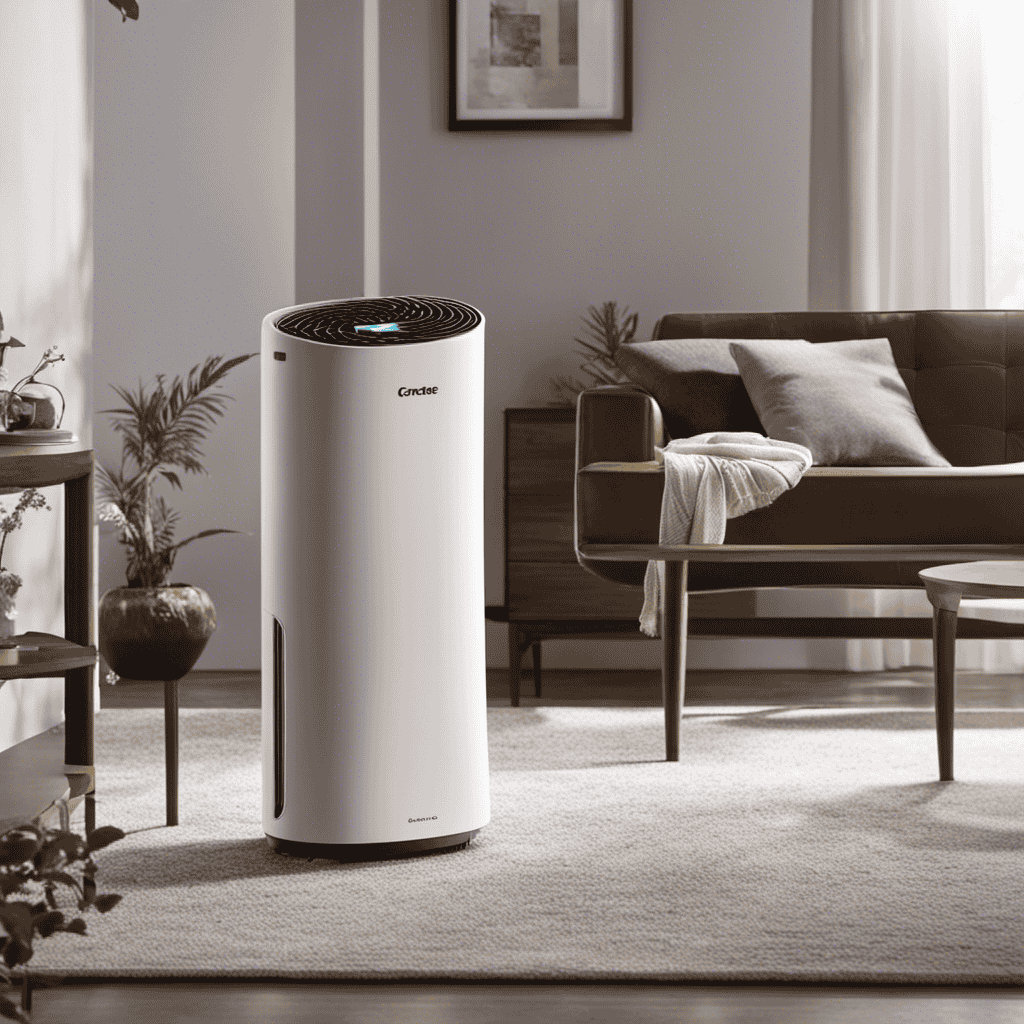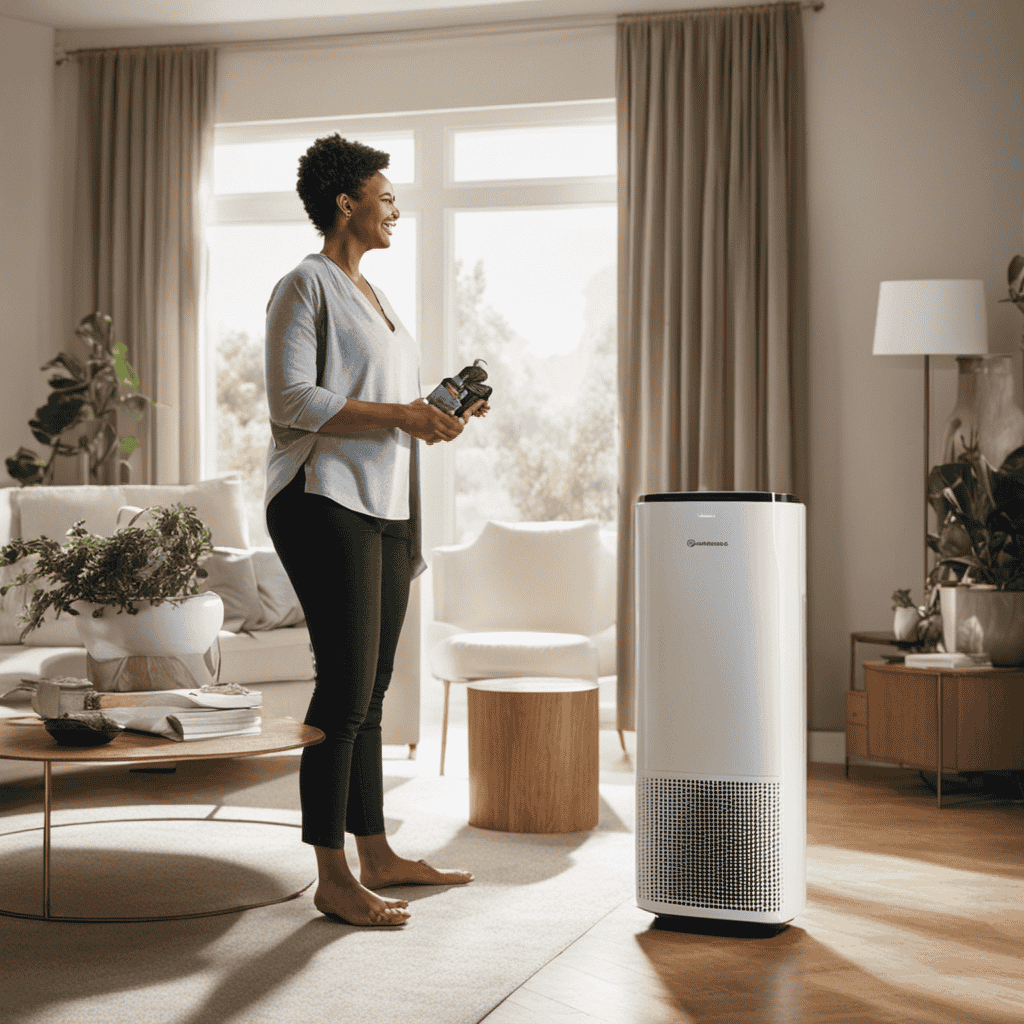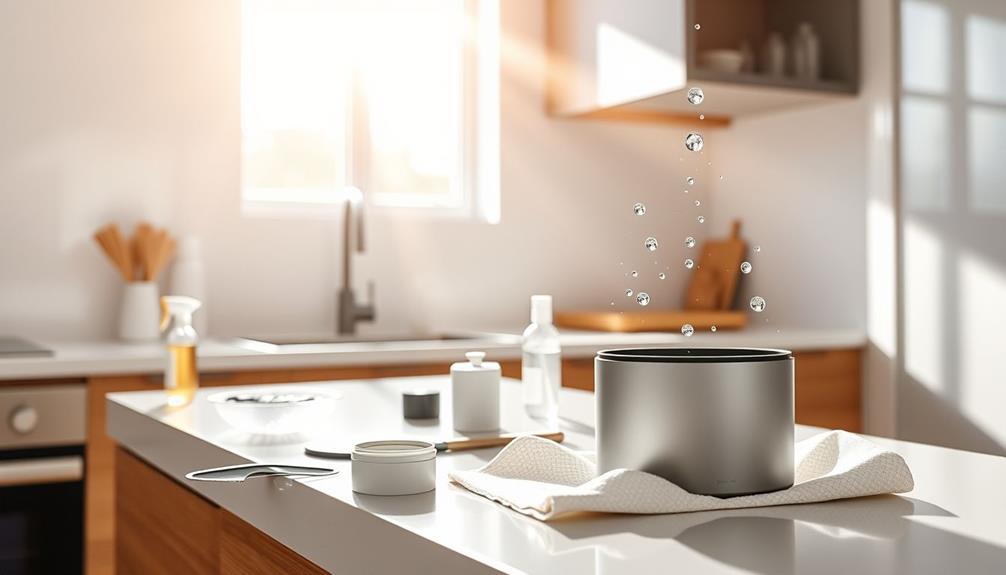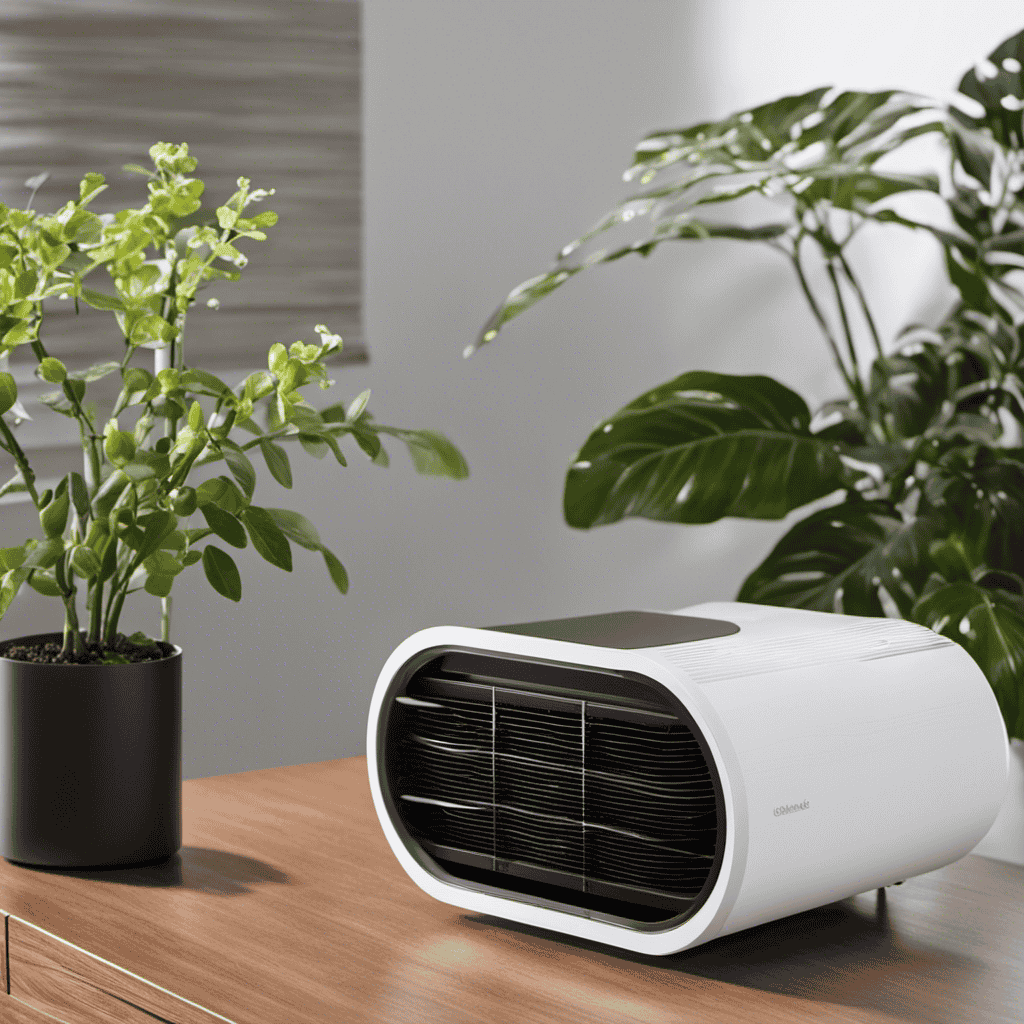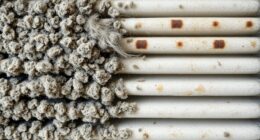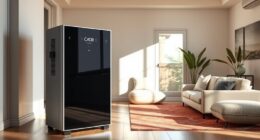For all the Holmes Egg Air Purifier owners, here’s some great news! Cleaning the filters on your air purifier is simpler than you may realize.
In this article, I’ll walk you through the step-by-step process of keeping your filters clean and your air fresh. We’ll cover everything from cleaning the pre-filter to maintaining the HEPA filter.
Plus, I’ll share some tips to help you extend the lifespan of your filters.
So, let’s dive in and get your air purifier running at its best!
Key Takeaways
- The Holmes Egg Air Purifier uses multiple filters, including a HEPA filter and a carbon filter, to provide comprehensive air purification.
- Regularly cleaning the filters is important to maintain a healthier indoor environment, remove harmful pollutants and allergens, and improve the efficiency of the air purifier.
- The pre-filter, which captures larger particles, should be cleaned every 2 weeks and replaced every 3-6 months.
- Alternative cleaning methods using vinegar solution, baking soda paste, and lemon juice solution can be used to reduce exposure to harsh chemicals when cleaning the filters.
Types of Filters Used in the Holmes Egg Air Purifier
There are two types of filters used in the Holmes Egg Air Purifier: a HEPA filter and a carbon filter. Each filter serves a different purpose and offers unique benefits.
The HEPA (High-Efficiency Particulate Air) filter is designed to capture and remove small particles from the air, such as dust, pollen, pet dander, and mold spores. It is highly effective in improving indoor air quality and reducing allergy and asthma symptoms.
On the other hand, the carbon filter is responsible for removing odors, smoke, and harmful gases from the air. It contains activated carbon, which has the ability to absorb and trap these pollutants.
Using multiple filters in the Holmes Egg Air Purifier provides a comprehensive air purification system, ensuring cleaner and fresher air in your home.
Importance of Regularly Cleaning the Filters
Make sure you regularly clean the filters to maintain optimal performance of your Holmes Egg air purifier. The importance of clean air cannot be overstated, as it directly affects our health and well-being.
Clean filters play a crucial role in ensuring that the air we breathe is free from harmful pollutants and allergens. By removing dust, pet dander, pollen, and other particles, clean filters help create a healthier indoor environment, reducing the risk of respiratory issues and allergies.
Additionally, clean filters also improve the efficiency of the purifier, allowing it to effectively capture and remove airborne contaminants.
Now that you understand the importance of clean filters, let’s dive into a step-by-step guide to cleaning the pre-filter.
Step-by-Step Guide to Cleaning the Pre-Filter
As an expert in air purifier maintenance, I’ll provide valuable information on pre-filter maintenance tips, cleaning frequency recommendations, and alternative cleaning methods.
Taking care of your pre-filter is essential for maintaining the efficiency of your air purifier and ensuring clean and fresh air in your home. I’ll guide you through the step-by-step process of cleaning the pre-filter and provide expert tips to prolong its lifespan.
Pre-Filter Maintenance Tips
To keep your Holmes egg air purifier running efficiently, it’s important to regularly clean the pre-filter. The pre-filter is responsible for capturing larger particles such as dust, pet hair, and lint, preventing them from clogging the main filter. Cleaning the pre-filter is simple and can be done in a few easy steps. Here are some pre-filter maintenance tips to ensure optimal performance:
| Cleaning Frequency | Cleaning Method | Replacement Frequency |
|---|---|---|
| Every 2 weeks | Vacuum or wash | Every 3-6 months |
Cleaning Frequency Recommendations
You should ensure that the main filter of your air purifier is cleaned regularly to maintain its efficiency in removing airborne contaminants. Cleaning the filter is crucial as it allows the air purifier to perform optimally, ensuring that the air in your home remains clean and healthy.
There are several cleaning techniques that you can use to ensure the longevity of your air purifier’s main filter. One common method is vacuuming the filter to remove any dust or debris that may have accumulated. Another technique is washing the filter with water and mild detergent, making sure to rinse it thoroughly before reinstalling it.
Alternative Cleaning Methods
Now that we know how often to clean the filters in our Holmes Egg Air Purifier, let’s explore some alternative cleaning methods. These methods offer natural cleaning solutions that can be just as effective as traditional cleaning agents.
Here is a table that outlines three alternative cleaning methods and their benefits:
| Method | Ingredients | Benefits |
|---|---|---|
| Vinegar Solution | White vinegar | Removes odors and disinfects |
| Baking Soda Paste | Baking soda, water | Absorbs odors and gently scrubs away dirt and stains |
| Lemon Juice Solution | Lemon juice, water | Provides a fresh scent and acts as a natural disinfectant |
These alternative cleaning solutions are not only effective but also environmentally friendly. By using natural cleaning methods, we can reduce our exposure to harsh chemicals while still maintaining a clean and healthy living environment.
Now, let’s move on to the next section where we will learn how to clean the carbon filter in the Holmes Egg Air Purifier.
How to Clean the Carbon Filter in the Holmes Egg Air Purifier
Filter maintenance is an essential aspect of ensuring the optimal performance of the Holmes Egg Air Purifier. The frequency at which you should clean the filters depends on various factors, such as the air quality in your environment and the usage of the purifier.
It is recommended to clean the pre-filter every 2 to 4 weeks and the carbon filter every 3 to 6 months to maintain efficient air purification. Regular cleaning not only helps to maintain the purifier’s effectiveness but also prolongs the lifespan of the filters, ensuring clean and fresh air in your surroundings.
Filter Maintenance Frequency
The frequency of cleaning the filters in the Holmes egg air purifier depends on how often I use it. As a knowledgeable user, I understand the importance of maintaining clean filters for optimal performance.
While the manufacturer recommends replacing the filters every 6-12 months, regular cleaning can help extend their lifespan. In addition to the standard cleaning method provided by Holmes, there are alternative cleaning methods that I can try.
For instance, gently vacuuming the filters or using compressed air can help remove dust and debris. It is also essential to keep the surrounding area clean and dust-free to prevent clogging and maximize filter efficiency.
Recommended Cleaning Methods
To properly maintain your Holmes egg air purifier, it’s important to regularly clean the filters using recommended methods. Cleaning the filters not only ensures the efficiency of your purifier but also prolongs its lifespan. The frequency of cleaning depends on various factors such as usage and air quality. However, as a general guideline, it is recommended to clean the filters every 3-6 months. There are alternative cleaning methods available for those who prefer not to use water or prefer a more eco-friendly approach. These methods include using a vacuum cleaner or a soft brush to remove dust and debris from the filters. It’s essential to follow the manufacturer’s instructions and guidelines when cleaning the filters to avoid damaging them.
Here is a helpful table summarizing the recommended cleaning methods and frequency for Holmes egg air purifier filters:
| Cleaning Method | Frequency |
|---|---|
| Water and mild soap | Every 3-6 months |
| Vacuum cleaner | Every 3-6 months |
| Soft brush | Every 3-6 months |
Importance of Regular Cleaning
Make sure you regularly maintain your Holmes egg air purifier by following the recommended cleaning methods and schedule.
Regular maintenance is of utmost importance to ensure the optimal performance of your air purifier and to enjoy the benefits of clean air in your home.
By regularly cleaning the filters and other components of the purifier, you can effectively remove airborne particles, allergens, and pollutants from your indoor environment. This helps improve the air quality and reduces the risk of respiratory issues and allergies.
Additionally, a well-maintained air purifier operates more efficiently, saving you energy and prolonging the lifespan of the device.
Proper Maintenance and Cleaning of the HEPA Filter
Ensure you regularly clean the HEPA filter of your Holmes egg air purifier to maintain its performance and effectiveness. A dirty HEPA filter can hinder the purifier’s ability to remove airborne particles effectively, affecting the air quality in your room. Here are the signs that indicate it’s time for a HEPA filter replacement:
-
Reduced Airflow: If you notice a decrease in the airflow, it could be due to a clogged or dirty HEPA filter. Cleaning or replacing the filter can restore the airflow and improve the purifier’s efficiency.
-
Increased Allergies or Respiratory Issues: A dirty HEPA filter may not effectively trap allergens, dust, and other contaminants, leading to an increase in allergies or respiratory issues. Regularly cleaning or replacing the filter can alleviate these symptoms.
-
Visible Dirt or Debris: If you see visible dirt or debris on the filter, it’s a clear indication that it needs cleaning or replacement. A clean filter ensures optimal performance and cleaner air.
Regular maintenance and cleaning of the HEPA filter is crucial to ensure your Holmes egg air purifier continues to provide clean and healthy air in your living space.
Tips for Extending the Lifespan of Your Holmes Egg Air Purifier Filters
Regularly replacing your Holmes egg air purifier filters can help extend their lifespan and maintain optimal performance. However, there are also techniques for cleaning the filters to further prolong their effectiveness.
One method is to vacuum the outer surface of the filter to remove larger particles and debris. This can be done using a handheld vacuum cleaner or by gently tapping the filter against a hard surface.
For a deeper clean, you can use a soft brush or a damp cloth to gently wipe the filter. It is important to avoid using harsh chemicals or excessive force, as this can damage the filter.
Frequently Asked Questions
How Often Should I Clean the Pre-Filter in the Holmes Egg Air Purifier?
I clean the pre-filter in my Holmes Egg Air Purifier regularly to maintain its efficiency. It’s important to follow the manufacturer’s instructions on how to clean it properly for optimal performance.
Can I Use Any Cleaning Solution to Clean the Carbon Filter?
Sure, any cleaning solution can be used to clean the carbon filter. However, it’s important to choose safe alternatives and follow proper cleaning methods to ensure optimal performance and longevity of the filter.
Is It Necessary to Replace the HEPA Filter or Can It Be Cleaned?
It is necessary to replace the HEPA filter as it cannot be effectively cleaned. Cleaning the filters regularly, however, can help maintain the performance of the air purifier and improve air quality.
How Long Do the Holmes Egg Air Purifier Filters Typically Last Before Needing to Be Replaced?
The Holmes egg air purifier filters typically last for about 6 to 12 months before needing to be replaced. It is recommended to replace the filters within this interval for optimal performance and air purification.
Are There Any Specific Maintenance Tasks I Should Regularly Perform to Keep My Holmes Egg Air Purifier Filters in Good Condition?
Regular maintenance is essential to keep my Holmes Egg Air Purifier filters in good condition. Following best practices ensures optimal performance. It’s important to clean filters regularly, extending their lifespan and improving air quality.
Conclusion
Well, folks, it looks like we’ve come to the end of our journey through the world of Holmes Egg Air Purifier filters.
After diving into the different types of filters and the importance of regular cleaning, we learned the ins and outs of keeping each filter spick and span.
Remember, folks, proper maintenance and regular cleaning are the keys to extending the lifespan of your air purifier filters.
So, don’t forget to give your filters some love and care to keep your air clean and fresh as a daisy!
Happy purifying!



